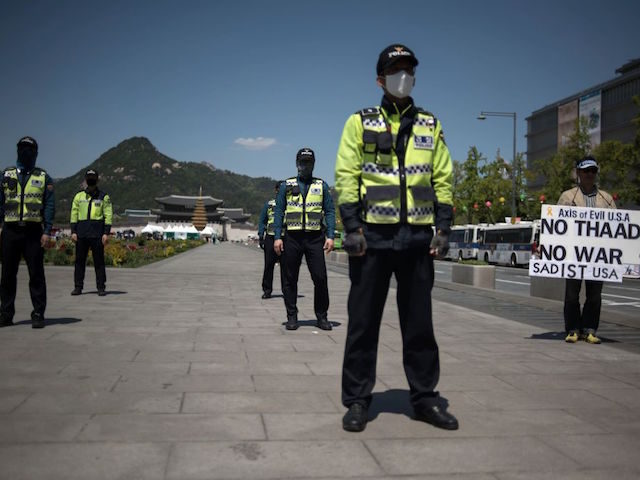American officials began the installment of the controversial Terminal High Altitude Area Defense (THAAD) system early Wednesday morning in South Korea where protesters greeted them despite the late and unannounced hour.
The THAAD system protects South Korea from incoming missiles and is designed to keep the nation safe from a North Korean missile attack. Neighboring countries like China and Russia have objected to the implementation of THAAD because its reach extends into their territory, far beyond where North Korea would be able to fire a missile.
According to the South Korean news agency Yonhap, the THAAD equipment arrived late Tuesday/early Wednesday in six trailers at the site of installation, a former golf course in Seongju, North Gyeongsang Province. The trailers carried “the high-profile X-band radar of the THAAD system, mobile launchers and other elements.” According to the report, hundreds of villagers in the area congregated to protest the deployment despite the late hour.
“People in Seongju, a traditionally tranquil town known for melon farming, are concerned that the area will become a prime target for the North’s rocket or missile attacks,” Yonhap explained, identifying protest signs reading, “No THAAD, No War,” and, “Hey, U.S.! Are you friends or occupying troops?”
The Korean Joongang Daily adds that many of the protesters were reportedly elderly local residents and that some were injured as police kept them from trying to intervene in the installation of the system. “Some 8,000 police were dispatched to the scene. They stood guard as the military trucks rolled in. Troops blocked roads to let the military vehicles pass and pushed back the residents and out-of-town protesters,” the Joongang report relays.
The South Korean Ministry of National Defense issued a statement to clarify the move Wednesday was the beginning of an extended installation process, as it occurred six days after the government acquired the property from the privacy Lotte Group corporation. “The measure this time is meant to secure early operational capability by positioning some available parts first at the site,” the ministry explained.
The Pentagon also issued a statement to Yonhap reiterating that THAAD is meant as a protective measure against North Korea. “North Korea’s unlawful weapons programs represent a clear, grave threat to U.S. national security,” the statement read. “North Korea openly states that its ballistic missiles are intended to deliver nuclear weapons to strike cities in the United States, the Republic of Korea, and Japan.”
These statements appear to have done little to convince China to stop criticizing the missile defense system.
During the Chinese Foreign Ministry’s regular briefing on Wednesday, spokesman Geng Shuang once again condemned THAAD. “The deployment of the THAAD system in the ROK by the US and the ROK will break the strategic balance in the region and further escalate the tensions on the Korean Peninsula,” he said. “It does no good to the goal of denuclearization of the Peninsula and regional peace and stability, runs counter to the efforts of various parties to resolve the issue through dialogue and consultation, and severely undermines China’s strategic security interests.”
American officials have rejected Chinese criticism of the THAAD system. “I find it preposterous that China would try to influence South Korea to not get a weapon’s system that’s completely defensive against the very country that’s allied with China,” Adm. Harry Harris, head of Pacific Command, told the House Armed Services Committee.

COMMENTS
Please let us know if you're having issues with commenting.